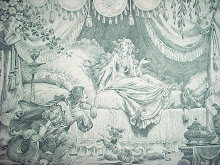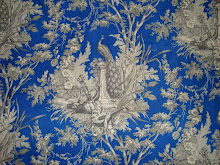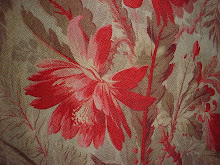











I would like to share some photos of a very treasured piece of cloth, a block-printed cotton chintz in the indienne style. I am sure it is a piece of original Toile de Jouy; while I don't have any references to the exact same design, I have shown here details from a print which is remarkably similar in design, colour, proportions etc, featured in the book Toile De Jouy Printed Textiles in the Classic French Style by Riffel, Rouart & Walter. My assumption is that my fabric was most likely designed and printed at the same time, perhaps in the same range as the one pictured and described in the book, which was the fabric used in the factory Drawing room at Jouy.
The fabric has been block printed with a series of small wood blocks, it is a polychrome print using six colours unlike the more well known monochrome printed genre toiles. At the time, green could only be produced on cotton by first printing with indigo for blue, then over-painting with yellow to produce a fresh green (it was possible to produce a dark, khaki-like green, but not a bright green on cotton). You can see this in photo where the yellow dye has extended slightly beyound the blue on a leaf, and on the reverse of the fabric. You can also see where the edges of the blocks were lined up, with a slight overlapping of the stippled background dots where the block was laid next to the previously printed section, see photo .
I love the last photo, showing the most ancient dainty darn, almost impossible to see with the naked eye, and very effective a repair it is, especially as the chintz retains quite a stiff starch glaze over the darn. I don't know much about contemporary glazes or laundry techniques, but it looks as though it was re-glazed or starched after the darn.
The fabric has been block printed with a series of small wood blocks, it is a polychrome print using six colours unlike the more well known monochrome printed genre toiles. At the time, green could only be produced on cotton by first printing with indigo for blue, then over-painting with yellow to produce a fresh green (it was possible to produce a dark, khaki-like green, but not a bright green on cotton). You can see this in photo where the yellow dye has extended slightly beyound the blue on a leaf, and on the reverse of the fabric. You can also see where the edges of the blocks were lined up, with a slight overlapping of the stippled background dots where the block was laid next to the previously printed section, see photo .
I love the last photo, showing the most ancient dainty darn, almost impossible to see with the naked eye, and very effective a repair it is, especially as the chintz retains quite a stiff starch glaze over the darn. I don't know much about contemporary glazes or laundry techniques, but it looks as though it was re-glazed or starched after the darn.



































































































I really enjoy your pices of text, illustrations and information, which are lively, scholarly and fun to read. It spurs me on to seek these rarities and make discoveries myself and back them up with the many good books on the different genres - keep posting us. Elizabeth, off to France in two days and can't wait to start the journey!
ReplyDeleteThis comment has been removed by the author.
ReplyDeleteThanks Elizabeth, your comments are always so welcome, I feel the same about your wonderful blog posts. Have a wonderful time in France, let me know if you find any toiles that you wish to sell! xx
ReplyDeleteoh,lovely lovely.
ReplyDeleteI am really enjoying seeing your early textiles along the side,too.
I love seeing these lovely bits that sing to your heart (and mine) and learning about them, too.
thank you for showing them and telling about them.
I also love the stippled background and the wonderful colors together.
that wee darn is especially dear.
I agree Christine, the darn is gorgeous. I love mends & darns old bits of stitching, anything that adds a personal touch to the textile from the wearer, owner etc is extra special! x
ReplyDeleteYou have stolen my heart with this textile. I have an endless fascination with toiles and especially the ones from Jouy. This one is so exquisite, really a gem.
ReplyDeleteI love your wonderful displays of textiles - and the text which is so interesting and informative. Thank you!
ReplyDeleteVery interessting
ReplyDeleteDo tou know the french "association des Amis du musée de la Toile de Jouy"
Perhaps it would be useful to exchange about your experience on this matter
best regards
philippe jaquard, member of this association.